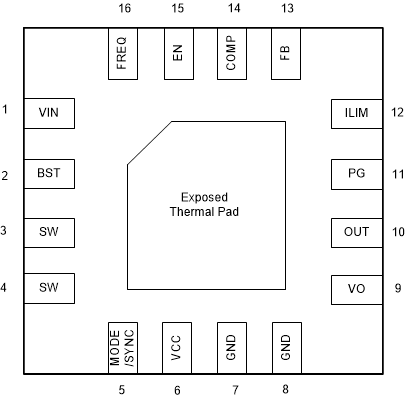SLVSET0E May 2020 – October 2024 TPS61378-Q1
PRODUCTION DATA
- 1
- 1 Features
- 2 Applications
- 3 Description
- 4 Device Comparison Table
- 5 Pin Configuration and Functions
- 6 Specifications
-
7 Detailed Description
- 7.1 Overview
- 7.2 Functional Block Diagram
- 7.3
Feature Description
- 7.3.1 VCC Power Supply
- 7.3.2 Input Undervoltage Lockout (UVLO)
- 7.3.3 Enable and Soft Start
- 7.3.4 Shut Down
- 7.3.5 Switching Frequency Setting
- 7.3.6 Spread Spectrum Frequency Modulation
- 7.3.7 Adjustable Peak Current Limit
- 7.3.8 Bootstrap
- 7.3.9 Load Disconnect
- 7.3.10 MODE/SYNC Configuration
- 7.3.11 Overvoltage Protection (OVP)
- 7.3.12 Output Short Protection/Hiccup
- 7.3.13 Power-Good Indicator
- 7.3.14 Thermal Shutdown
- 7.4 Device Functional Modes
-
8 Application and Implementation
- 8.1 Application Information
- 8.2
Typical Application
- 8.2.1 Design Requirements
- 8.2.2 Detailed Design Procedure
- 8.2.3 Application Curves
- 9 Power Supply Recommendations
- 10Layout
- 11Device and Documentation Support
- 12Revision History
- 13Mechanical, Packaging, and Orderable Information
5 Pin Configuration and Functions
 Figure 5-1 16-Pin WQFN RTE Package
(Transparent Top View)
Figure 5-1 16-Pin WQFN RTE Package
(Transparent Top View)Table 5-1 Pin Functions
| PIN | I/O | DESCRIPTION | |
|---|---|---|---|
| NAME | NO. | ||
| VIN | 1 | I | IC power supply input |
| BST | 2 | I | Power supply for high-side N-MOSFET gate drivers. A capacitor must be connected between this pin and the SW pin. |
| SW | 3, 4 | PWR | The switching node pin of the converter. It is connected to the drain of the internal low-side FET and the source of the high-side FET. |
| MODE/SYNC | 5 | I | Mode selection pin. MODE = high, forced PWM mode MODE = low or floating, auto PFM mode This pin can also be used to synchronize the external clock. Refer to Table 7-2 for details. |
| VCC | 6 | O | Output of internal regulator. A ceramic capacitor with more than 1 μF must be connected between this pin and GND. |
| GND | 7, 8 | PWR | Power ground of the IC. It is connected to the source of the low-side FET. |
| VO | 9 | PWR | Output of the isolation FET. Connect load to this pin to achieve input/output isolation. |
| OUT | 10 | PWR | Output of the drain of the HS FET. Connect this pin because the output can disable the load disconnect/short protection feature (or short this pin with the VO pin). |
| PG | 11 | O | Power good indicator and open drain output |
| ILIM | 12 | I | Current limit setting pin. Use a resistor to set the desired peak current limit. Refer to Section 7.3.7 for details. |
| FB | 13 | I | Feedback pin. Use a resistor divider to set the desired output voltage. Refer to Section 8.2.2.1 for details. |
| COMP | 14 | I | Output of the internal transconductance error amplifier. An external RC network is connected to this pin to optimize the loop stability and response time. |
| EN | 15 | I | Enable logic input |
| FREQ | 16 | I | Frequency setting pin. Connect a resistor between this pin and GND pin to set the desired frequency. |
| Thermal Pad | - | - | The thermal pad must be connected to the power ground plane for good power dissipation. |